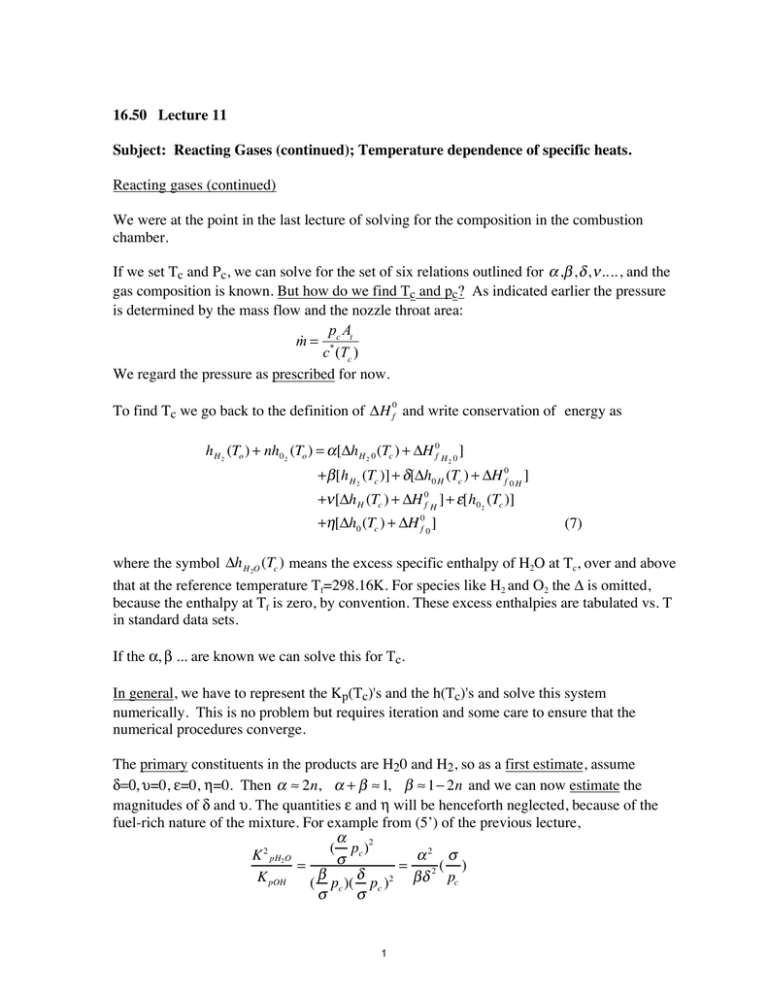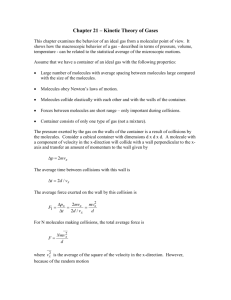Reacting gases (continued) 16.50 Lecture 11
advertisement

16.50 Lecture 11 Subject: Reacting Gases (continued); Temperature dependence of specific heats. Reacting gases (continued) We were at the point in the last lecture of solving for the composition in the combustion chamber. If we set Tc and Pc, we can solve for the set of six relations outlined for ! ," , # , $ .... , and the gas composition is known. But how do we find Tc and pc? As indicated earlier the pressure is determined by the mass flow and the nozzle throat area: pA m! = * c t c (Tc ) We regard the pressure as prescribed for now. To find Tc we go back to the definition of !H f and write conservation of energy as 0 h H 2 (To ) + nh0 2 (To ) = ! ["h H 2 0 (Tc ) + "H 0f H 0 ] 2 +! [h H 2 (Tc )] + "[#h0 H (Tc ) + #H 0f 0 H ] +! ["h H (Tc ) + "H 0f H ] + #[h0 2 (Tc )] +!["h0 (Tc ) + "H 0f 0 ] (7) where the symbol !h H 2O (Tc ) means the excess specific enthalpy of H2O at Tc, over and above that at the reference temperature Tf=298.16K. For species like H2 and O2 the Δ is omitted, because the enthalpy at Tf is zero, by convention. These excess enthalpies are tabulated vs. T in standard data sets. If the α, β ... are known we can solve this for Tc. In general, we have to represent the Kp(Tc)'s and the h(Tc)'s and solve this system numerically. This is no problem but requires iteration and some care to ensure that the numerical procedures converge. The primary constituents in the products are H20 and H2, so as a first estimate, assume δ=0, υ=0, ε=0, η=0. Then ! " 2n, ! + # " 1, # " 1$ 2n and we can now estimate the magnitudes of δ and υ. The quantities ε and η will be henceforth neglected, because of the fuel-rich nature of the mixture. For example from (5’) of the previous lecture, ! ( pc )2 2 K pH2 O !2 " " = = ) 2( # $ K pOH ( pc )( pc )2 #$ pc " " 1 " 2 $ K pOH ! = ( ) # pc K 2pH 2O 2 and for σ=α+β=1 and the above estimates for α and β, !2 = (2n)2 1 K pOH 1" 2n pc K 2pH 2O We now need an estimate of Tc. From (7), and using constant specific heats, h H 2 (To ) + nhO2 (To ) ! 2n["h H 2 0 (Tc ) + "H 0f H 0 ] 2 +(1-2n)[hH (Tc)] 2 where we read from tables !H f H2 0 = "57.8 0 kcal gmole and we approximate for now cpH2= 7.5 cal/mole/K cpH2O = 10.6 cal/mole/K Let h(To)=0 (as noted above this is arbitrary: we assume we are injecting gaseous H2 and O2 at t0=298K). The energy balance then becomes 0=2n[(10.6)(Tc-298)-57,800]+(1-2n)[7.5(Tc-298)] and we can solve this for (Tc-298): 2n(57,800) 1.15×105 n = Tc − 298 = 2n(10.6) + (1− 2n+)7.5 7.5 6.20n To proceed further we must specify n. Let us take n=0.25, or half the stoichiometric value of 0.5. This corresponds to an Oxygen/Hydrogen mass ratio of 4. A more usual value is about 5. Then we find Tc = 3480 K as a first estimate. Now we have to check to see what the actual composition is for this temperature. Using the methods explained before, the values of Kp0H and KpH 0 at the estimated temperature are: 2 n Tc 0.25 3480 Kp,0H 1.70 Kp,H20 atm1/2 4.93 And from our previous result for δ, p1/2 c ! = 0.19 , so now if pc=100 atm, δ=.019 as a second estimate, compared to the original estimate of 0. What about ν? From Eq. (4) of the previous lecture, 2 ! ( ) 2 pc 2 ! 2 p pH2 c = KpH = = " # " # pH 2 ( ) pc " $ 2 ! " #K pH (Tc )( ) pc For n = .25, Tc = 3480°K, we calculate from the standard chemical potentials KpH = .35 atm, 1 .42 so ν 2 = (0.5)(.35) ; ν = 1/2 pc pc For pc = 100 atm, and the estimated temperature, we now have ν = .042 as a second estimate. So, using Eqs. (2) for α and (1) for β, we find α=2x0.5-0.019=0.481, and β=1-0.481-(0.019+0.042)/2=0.489: H2 + .25 02 ! (.481)H2 O + (. 489)H2 + (.019)OH + (.042)H With this composition we can now go back and calculate Tc more accurately: 0 = hH2(To) + .25 h02(To) = .481 [10.6(Tc-298)-57,800] +.489 [7.5(Tc-298)] + .019 [7.8(Tc-298)+10.06] + .042 [5(Tc-298)+ 52.09] Tc-298 = .481(57, 800)!.019(10.06)!.042(52.09) =3047 .481(10.6)+.489(7.5)+.019(7.8)+.042(5) Tc=3345 K We stop the iteration here. A useful observation is that, just as the first approximation for Tc was too high because it ignored the endothermic dissociations, the second is likely to be too low, because it must have over-estimated these dissociations, since the equilibrium shifts in favor of dissociation when the temperature is high. It is a good idea to under-relax the temperature, as for example using for the next estimate the average of the previous two: 1 Tc ! (3480 + 3345) = 3413 K 2 Temperature dependence of specific heats In working through the above example, we assumed for simplicity that the specific heats of the gases were constant. In fact they vary with temperature, generally increasing with increasing temperature. Generally we account for this by taking the specific heat or the enthalpy from tables of thermodynamic properties. But it is desirable for you to understand qualitatively why the specific heat varies, hence the following discussion. 3 For a full understanding of this subject one must have recourse to Statistical Mechanics, which deals with the thermal behavior of matter from a microscopic viewpoint, drawing on quantum mechanics. There is not time for such a discussion here, so we must be content with a summary of some of the results. A key concept is that of active degrees of freedom. This is the number of terms in the classical expression for total energy that are quadratic in a coordinate or a velocity component. According to the Law of Equipartition of Energy each of these states if fully excited will contain an energy per mol of ℜT/2 where ℜ is the ideal molar gas constant. Real molecules behave quantically, so at low enough temperatures, where the quantum of energy is greater than the available thermal energy per molecule, a quantum degree of freedom may not be “active”. Generally, translational and rotational quanta are small enough that translational degrees of freedom are regarded as active in all cases of interest to us, but vibrational freedoms become active only at temperatures of the order of 2,000-3,000K. Taking the simplest case first: a) Monoatomic gases The molecule of a monoatomic gas can be thought of as a point mass, and as such it has three translational degrees of freedom. So the Internal Energy (per mol) is 3ℜT/2, so we find a molar Specific Heat at Constant Volume cv=12.47 Joule/mole/K ( Monatomic) The ideal gas constant being ℜ= 8.32J/mole/K, the Specific Heat at Constant Pressure is cp= cv+ℜ= 20.79 Joule/kg mole/K and the ratio of specific heats is γ=5/3= 1.667. All of these values are independent of temperature because the translational degrees of freedom are fully excited at normal temperatures. b) Diatomic molecules. The simplest non-trivial case, the diatomic molecule, may be thought of as a "dumbbell" with in general unequal weights on the two ends, connected by a spring that can extend along the line of their common centers. Like the monoatomic molecule, the diatomic molecule as a whole has 3 translational degrees of freedom, each containing energy ℜT/2 per mol. In addition it has 2 rotational degrees of freedom (note that the moment of inertia about the line of centers is very small, so this degree of freedom does not count). Each of these rotational degrees of freedom is fully excited at the temperatures of interest here (though not at very low T) and contains ℜT/2. So at "low" temperatures (near room temperature) the Internal Energy per mole is 5ℜT/2 and the Specific Heat at Constant Volume is cv=20.79 Joule/mole/K ( Diatomic at low T) 4 It follows that and γ=7/5= 1.4. cp= cv+ℜ= 29.11 Joule/mole/K (Diatomic at low T) At higher temperatures, the vibration of the molecule along its line of centers is excited, introducing two more degrees of freedom. This happens gradually between room temperature and the maximum temperatures encountered in propulsion devices. It is this variation that causes the variations of cv of interest to us here. If the vibrational degrees of freedom are fully excited, the Internal energy per mole is 7ℜT/2 and cv=37.41 Joule/mole/K ( Diatomic at high T) Correspondingly, and γ=9/7= 1.286. cp= cv+ℜ= 45.73 Joule/mole/K (Diatomic at high T) c) Polyatomic Molecule Most polyatomic molecules are non-linear, so they have an additional rotational degree of freedom as compared to diatomic molecules. Thus at low temperatures, the Internal Energy is 6ℜT/2=3ℜT. It follows that cv=24.94 Joule/mole/K (Polyatomic at low T) cp= cv+ℜ= 33.260 Joule/mole /K (Polyatomic at low T) and the ratio of specific heats is γ=4/3= 1.333. The behavior of the vibrational degrees of freedom of polyatomic molecules can be very complex if the number of atoms is large. A useful rule for estimating their energy content is to compute the number of vibrational degrees of freedom as the difference of the total for the molecule minus the translational and rotational degrees of freedom. Thus if N is the number of atoms, Vibrational Degrees of Freedom = 3N-6, and the Internal Energy per molecule if they are all excited is 3kT+(3N-6)kT=(3N-3)kT. The ratio of specific heats then becomes ! = 3N " 2 (Polyatomic at high T) 3N " 3 and it is clear that this can be close to 1 for N large. 5 MIT OpenCourseWare http://ocw.mit.edu 16.50 Introduction to Propulsion Systems Spring 2012 For information about citing these materials or our Terms of Use, visit: http://ocw.mit.edu/terms.






